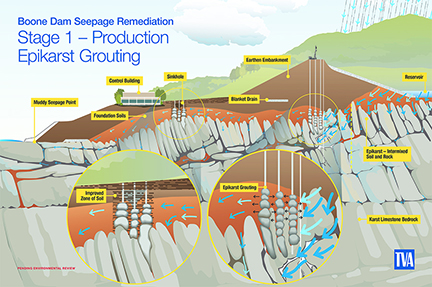By Scott Robertson
The Tennessee Valley Authority Thursday announced its plan to address seepage issues at Boone Dam. John McCormick, TVA vice president of Safety, River Management and Environment told a crowd of just over 300 at a public information session in Johnson City, “We have benchmarked this project. We have looked at many dams that have gone through this kind of repair, and the benchmark for this type of operation is about five to seven years to perform.” After a few seconds of catcalls from disappointed attendees, McCormick continued, “It’s also going to cost in the neighborhood of between $200-300 million to install, but I will tell you, this is a permanent repair for this reservoir. This is doing it right.”
TVA has been studying the extent of, and potential solutions for the seepage problem since it was discovered in the earthen portion of the dam last October. Investigation of a sinkhole at that time led to the discovery of a series of underground geological pathways allowing water “piping” to cause internal erosion. If left uncorrected, McCormick said, the erosion could eventually lead to the failure of the dam.
McCormick outlined the steps that will be taken in completing the dam repairs.
“We looked at many, many options,” McCormick said. “We had to. We are required by law to look at many options. Our long-term fix is to insert a concrete cutoff wall in the earthen dam. That concrete wall will go in in three stages.
“Stage one will require us to drill multiple columns and multiple rows from the concrete structure all the way past the beach area,” McCormick said. “About 500 borings will have to be done. We will drill down into the epikarst and insert low-mobility grout. To help you see low-mobility grout in you mind, think of cold toothpaste.
“Stage two will also require us to put multiple borings into the earthen dam,” McCormick said. “In this case, there will be three across the entire length of the dam. This will go down 250 to 300 feet into bedrock. Again, the intent of drilling down and inserting this low mobility grout, which will harden under the surface of the earth, is to stop the water flow.
“The third and final stage is putting in this ‘concrete’ – and it’s not actually concrete, it’s a composite that acts like concrete – cut-off wall. This wall is going to go from the top of the crest down as far as 250 feet. It will be multiple feet thick. And again, it will run the entire length of the earthen dam.”
McCormick told the largely skeptical crowd that TVA has been working with private firms to analyze the problem before choosing the five-to-seven-year option. “We reached out to industry experts, some of the best in the world who have worked on other dams facing the same issue, to help us identify what the risks were and what some opportunities and options were to repair this dam.
“This option is a very robust option,” McCormick added. “We did intensive research, a comprehensive and thorough investigation. That has led us to this option being the best option to pursue.”
While preliminary work is already underway, said John Kammeyer, vice president of Construction, an environmental study must be completed before work can begin in earnest.
“There are only three companies in the world that can do this,” Kammeyer said. “We have been working with one of them. We will be putting the full job out to bid.”
Rebecca Tolene, vice president of Natural Resources and Real Property Services, answered questions about specific property issues, such as who will be responsible for maintenance and trimming of the new plant growth in areas once covered by water. She also gave details of two planned boat ramp extensions, at DeVault Bridge and Pickens Bridge.
Many attendees were unimpressed by TVA’s presentation. The first member of the general public to address the TVA panel, Scott West, said, “Five to seven years is unacceptable. Let’s put things in perspective. The Empire State Building in New York City was built in one year and 45 days. The Hoover Dam, the largest dam in this country, was built in five years. The San Francisco Bridge – four years. And you guys can’t fix a water leak in five to seven years.”
“We had other options,” McCormick said. “We could do it faster. But we would find ourselves in the very same position we are today again. (Doing it faster) is not a permanent, or even a long-term repair.
“This is a permanent repair that puts us in a position to deal with sinkholes that come up in the future without having to take that water level down.”












